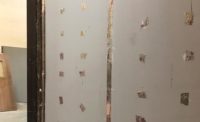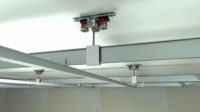Misconceptions of Sound Ratings
The Sound Truth


CEMCO FAS Track 1000 provides a sound gasket seal against concrete decks which will allow the wall to move without compromising fire, smoke, or sound ratings.

Acoustic sealant at the head of wall joint will commonly pull away or shrink back, from the drywall with minimal movement





Contractors beware! With multi-story residential construction on the rise across the country, construction defects lawyers are looking for new untapped markets for business. Underperforming STC ratings seem to be one area they have their sights set on. Over the past 20 years, mold issues have been on the forefront of construction defects litigation. This has resulted in better design practices and better materials. However, it has given growth to a new segment of the industry: Construction Defects Litigation.
Across the country there are all different types of third party design groups and consultants that can assist in every area of design in order to prevent defects or underperforming wall assemblies. Sound consultants are one such group that will design and assist architects in achieving the code required STC rating. As a contractor if you find yourself on the receiving end of a sound consultant’s recommendations, here are some realities to keep in mind.
Integer Rating
Sound transmission class is an integer rating of how well a building partition attenuates airborne sound. In North America it is generally used to rate interior wall partitions, ceilings/floors, doors/windows and even exterior wall configurations. Impact Insulation Class (IIC) measures a floor/ceiling assembly’s resistance to the transmission of structure-borne or impact noise.
The STC rating is determined by the wall assembly; materials used, stud layout, wall type, thickness of batt insulation and layer(s) of gypsum drywall installed. As a builder you may have a detail in your project drawings depicting a 3?-inch metal stud wall, single layer drywall on each side and batt insulation. Under that detail the architect may have a notation for STC 50. THIS DOES NOT MAKE IT AN STC 50 WALL ASSEMBLY! Depending on the thickness of the stud, the spacing of the studs and the thickness of the batt insulation, this wall will generally result in an STC rating between 43 and 48.
Why would an architect put in a notation for a 50 STC? It is because STC 50 is the minimum code requirement for residential construction. Section 1207 of International Building Code 2006 states that separation between dwelling units, as well as between dwelling units and public and service areas must achieve STC 50 for both airborne and structure-borne.
If you find this type of notation on a wall that will not achieve the noted STC rating, you will be better off bringing this up with the architect as soon as possible. When you bring it up with the architect be sure to do your research. A variety of sound reports can be found online or in the “Catalog of STC and IIC Ratings for Wall and Floor/Ceiling Assemblies.” This way you can properly point out to the architect that the noted STC rating in not achievable. From there you can ask the architect for direction or to recommend a solution that will achieve the required STC rating.
Simple Ways to Improve STC Ratings
- Adding an extra layer of gypsum drywall to just one side of the wall will generally increase your STC rating by 2 points.
- Cold-Formed metal stud framing will get a better STC rating than wood framed walls. Generally, the thinner the steel, the better the STC rating. Sound consultants or architects may recommend the thinnest metal stud available to increase STC ratings but walls not only have to provide sound ratings but must also provide load values. Products like CEMCO Viper Stud are specially designed to increase the limiting heights (the max wall height in which the stud can be used and still provide the required deflection and load of the structure) in a thinner steel to increase the STC ratings.
- Double Wall Construction: Typically two 2½-inch wide metal stud walls with a 1-inch gap in between will decouple sound vibration from one side of the wall to the other and will provide greater STC ratings. This will require building two separate walls and will be slightly wider than a single wall construction, but the improved STC rating may prove worth the extra work.
- Soundproofing clips with hat channel and properly installed resilient channel will also aid in decoupling the drywall sound vibrations from one side to the other and for single wall construction it may be the best way to increase STC ratings.
Framing Stud Considerations
- Making the drywall surface less rigid will reduce sound vibration and increase STC ratings. That said, metal studs are much more flexible than wood studs and will generally offer STC ratings 2-4 points higher on matching wall assemblies.
- Changing the stud layout from 16 inches-on-center to 24 inches-on-center will make the wall less rigid and improve STC ratings.
- Increasing the width of the wall cavity will also increase STC ratings.
- Wall Insulation: Many may assume that the thicker the wall batt insulation the better the STC rating. This is not necessarily the case. Having a small air space between the insulation and the drywall can actually improve the STC ratings and there are many sound reports that will prove this theory.
- Deflection Movement: Structural engineers will calculate and design the anticipated movement into structures. Once the movement criteria is established, the UL head-of-wall joint systems can be submitted for approval but that is only for the fire rated walls. Currently, there are no movement tests for sound walls and this is becoming a big issue. If the fire rated walls are designed with ½-inch (+/-) movement and the sound walls are designed with a static joint (1/2-inch gap filled with acoustic sealant), when the structure does move the head-of-wall joints on the sound walls will be severely compromised. When sound wall joints are compromised STC ratings can also be compromised.
Acoustic Sealant
Acoustic sealants are not generally designed to accommodate dynamic movement the same way fire sealants or intumescent products are. Acoustic sealants can split and pull away from the edge of the drywall or concrete when movement occurs. It would make more sense to sound test the wall assembly after cyclical movement but that test standard has yet to be implemented. Unfortunately, these compromised head-of-wall joints on sound walls can open the door for potential construction defect cases.
Conclusion
As a builder, owner or architect, how can you protect yourself from potential construction defects litigation? Select products that will provide an uncompromised seal between the drywall and the framing at all times no matter how much the drywall cycles up and down. Products like FAS Track 1000 or Deflection Drift Angle (DDA) are specifically designed to protect against fire, smoke and sound passage. These products allow the drywall to maintain a tight seal against the framing without the use of acoustic sealant or allowing sound flanking paths at the head-of-wall joint caused by gaps in the drywall to occur as the drywall bumps out around the framing fasteners that go through the track into the stud.
When it comes to dynamic movement of a building structure, fire ratings and sound ratings actually go hand and hand and should be treated that way.
Looking for a reprint of this article?
From high-res PDFs to custom plaques, order your copy today!










